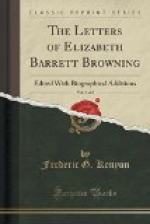The former of these allegations is of little weight. Whatever qualities Miss Barrett may have shared with Tennyson, her substantial independence is unquestionable. It is a case rather of coincidence than imitation; or if imitation, it is of a slight and unconscious kind. The second criticism deserves fuller notice, because it is constantly repeated to this day. The following letters show how strongly Miss Barrett protested against it. As she told Horne,[105] with reference to this very subject: ’If I fail ultimately before the public—that is, before the people—for an ephemeral popularity does not appear to me to be worth trying for—it will not be because I have shrunk from the amount of labour, where labour could do anything. I have worked at poetry; it has not been with me reverie, but art.’ That her rhymes were inexact, especially in such poems as ’The Dead Pan,’ she did not deny; but her defence was that the inexactness was due to a deliberate attempt to widen the artistic capabilities of the English language. Partly, perhaps, as a result of her acquaintance with Italian literature, she had a marked fondness for disyllabic rhymes; and since pure rhymes of this kind are not plentiful in English, she tried the experiment of using assonances instead. Hence such rhymes as silence and islands, vision and procession, panther and saunter, examples which could be indefinitely multiplied if need were. Now it may be that a writer with a very sensitive ear would not have attempted such an experiment, and it is a fact that public taste has not approved it; but the experiment itself is as legitimate as, say, the metrical experiments in hexameters and hendecasyllabics of Longfellow or Tennyson, and whether approved or not it should be criticised as an experiment, not as mere carelessness. That Mrs. Browning’s ear was quite-capable of discerning true rhymes is shown by the fact that she tacitly abandoned her experiment in assonances. Not only in the pure and high art of the ‘Sonnets from the Portuguese,’ but even in ‘Casa Guidi Windows,’ the rhetorical and sometimes colloquial tone of which might have been thought to lend itself to such devices, imperfect rhymes occur but rarely not exceeding the limits allowed to himself by every poet who has rhymed given and heaven; and the roll of those who have not done so must be small indeed.
[Footnote 105: Letters to R.H. Horne, ii. 119.]
The point has seemed worth dwelling on, because it touches a commonplace of criticism as regards Mrs. Browning; but we may now make way for her own comments on her critics and friends.
To H.S. Boyd Tuesday, August 13, 1844 [postmark].
My very dear Friend,—I must thank you for the great kindness with which you have responded to a natural expression of feeling on my part, and for all the pleasure of finding you pleased with the inscription of ‘Cyprus Wine.’ Your note has given me much true pleasure. Yes; if my verses survive me, I should wish them to relate the fact of my being your debtor for many happy hours.




